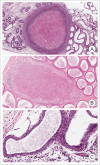The blood-epididymis barrier and inflammation
- PMID: 26413391
- PMCID: PMC4581054
- DOI: 10.4161/21565562.2014.979619
The blood-epididymis barrier and inflammation
Abstract
The blood-epididymis barrier (BEB) is a critical structure for male fertility. It enables the development of a specific luminal environment that allows spermatozoa to acquire both the ability to swim and fertilize an ovum. The presence of tight junctions and specific cellular transporters can regulate the composition of the epididymal lumen to favor proper sperm maturation. The BEB is also at the interface between the immune system and sperm. Not only does the BEB protect maturing spermatozoa from the immune system, it is also influenced by cytokines released during inflammation, which can result in the loss of barrier function. Such a loss is associated with an immune response, decreased sperm functions, and appears to be a contributing factor to post-testicular male infertility. Alterations in the BEB may be responsible for the formation of inflammatory conditions such as sperm granulomas. The present review summarizes current knowledge on the morphological, physiological and pathological components associated with the BEB, the role of immune function on the regulation of the BEB, and how disturbance of these factors can result in inflammatory lesions of the epididymis.
Keywords: ABC transporters; claudins; defensin; granuloma; sperm maturation.
Figures






References
-
- Hinton BT, Howards SS. Permeability characteristics of the epithelium in the rat caput epididymidis. J Reprod Fertil. 1981; 63:95-9; PMID:7277337; http://dx.doi.org/10.1530/jrf.0.0630095 - DOI - PubMed
-
- Friend DS, Gilula NB. Variations in tight and gap junctions in mammalian tissues. J Cell Biol. 1972; 53:758-76; PMID:4337577; http://dx.doi.org/10.1083/jcb.53.3.758 - DOI - PMC - PubMed
-
- Suzuki F, Nagano T. Regional differentiation of cell junctions in the excurrent duct epithelium of the rat testis as revealed by freeze-fracture. Anat Rec 1978; 191:503-19; PMID:697060; http://dx.doi.org/10.1002/ar.1091910409 - DOI - PubMed
-
- Cyr DG, Robaire B, Hermo L. Structure and turnover of junctional complexes between principal cells of the rat epididymis. Microsc Res Tech 1995; 30:54-66; PMID:7711320; http://dx.doi.org/10.1002/jemt.1070300105 - DOI - PubMed
-
- Agarwal A, Hoffer AP. Ultrastructural studies on the development of the blood-epididymis barrier in immature rats. J Androl 1989; 10:425-31; PMID:2621151 - PubMed
Publication types
LinkOut - more resources
Full Text Sources
Other Literature Sources
Molecular Biology Databases
